26 October, 2004
Waiting to go to Cape Chocolate.
The weather has been pretty much perfect the whole time we've been here....except today, when we are all ready to go to Cape Chocolate. Clouds were moving in from the south this morning. This is the direction from which weather usually comes.
I was scheduled to check in at 8:15 for the 9:00 helo flight, but when I went to lab Stacy said we had a weather delay. We were to call in at 10:00 to get an update. At 10:00, we were told to call in at noon. It started snowing, At noon we were told to call back at 2:00. Finally, at about 2:30, the flight was cancelled altogether for the day. Some of the gear was already taken over by helo yesterday. It's all wrapped up in a sling load that hangs on a rope from the helicopter. We imagine it now sitting on the ice, getting covered with snow.
While we are waiting, we check our e-mail, write updates, and go to the galley for an actual hot lunch. It's Kathy's day to do the update for the ASPIRE web site and she has had the idea for a while to take pictures of all the art around town. After lunch, I went with her to photograph some of the art that's here and there in buildings and outside. There's a huge steel killer whale made out of chains, steel bar, and other pieces off various machines. It sits overlooking the "transition" - the area between ice and land. There is a program called the Antarctic Artists and Writers Program, in which artists and writers can receive funding from the National Science Foundation to spend time here and write or create art. There are photographs and paintings on the walls in several buildings that were done by people on one of these grants.
An artist from Rhode Island, Lucia DeLeiris, came here three different times painting and drawing as part of an Artists and Writers grant. You can see some of her beautiful paintings at www.luciadeleiris.com/antarctica/. She has also illustrated a children's book written by Meredith Hooper, called Antarctic Journal.
Much of the art, though, is things that people have just created. There are a lot of creative people here, and, combined with having some time on their hands sometimes, some very interesting things have resulted.
Kathy and Andrew have also begun picking and sorting of some of the core samples. Since each sample may contain hundreds of tiny worms, mollusks, crustaceans, anemones, and other animals, this process can be time-consuming. Kathy said the one she just did took her about 5 hours from beginning to end. However, she said, if she weren't so familiar with the animals, it might take her a week to identify them. There are some crustaceans that aren't as familiar to her as some of the other organisms, so she will save those for one of her assistants where she works, at the Canadian Museum of Nature, to identify.
Kathy also told me today about some of the work that she is doing in the Arctic. She works at the Canadian Museum of Nature and has been doing research on ice scours in the Beaufort Sea, which is north of the eastern part of Alaska and the Yukon Territories in Canada. Ice scours are places where the ice - such as from a glacier or icebergs - has dragged across the bottom and cleared the surface, often pushing sediment up on wither side. For example, here in Antarctica, beneath pressure ridges, such as those in the pictures of Cape Chocolate yesterday, are sharp pieces of ice that extend far beneath the surface of the ice and drag along the bottom. This of course changes the communities that live in that area - a little bit like having your neighborhood bulldozed and starting over. Kathy is looking at how organisms grow in the sediments at these scours, what organisms might move in once it's been scoured, and how long it would take to return to the way it was before the area
was scoured (perhaps 30 years).
The area in the Beaufort Sea that Kathy is studying is about 100 kilometers across and the water is about 30 meters deep. The Canadian Geological Survey uses sonar from ships to make a three dimensional picture of what the sea floor looks like. The ship can send out sonar in many different directions at once to get a very detailed picture of the bottom. It's amazing to see the "tracks" that are left behind by the ice. By having detailed images, they can even keep track of which scours are new and they know how old they are. Kathy also dives to survey the bottom, much as she does here. Imagine diving at the bottom of an iceberg!
Larger animals play a role in these Arctic bottom communities too - for example, walruses eat clams that live at the bottom and some whales may stir up the bottom by dragging their mouths through the sediments looking for small organisms to eat. Yum!
It's disappointing not to be at Cape Chocolate by now, but I have had a chance to see and learn about some things that I otherwise might not have. There is always more to learn!
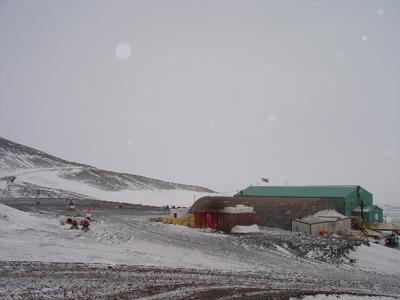
1. No visibility, no helo flight!
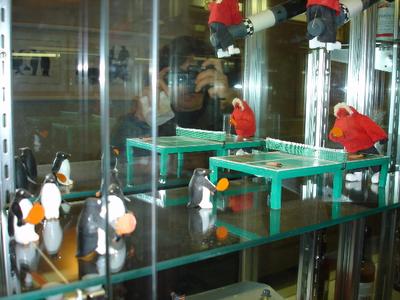
2. A display of "beaker art" on the way in to the galley (cafeteria). "Beaker" is an Antarctic term for scientists of any type. These little figures show beakers in red parkas doing all kinds of things, including playing ping pong with penguins.
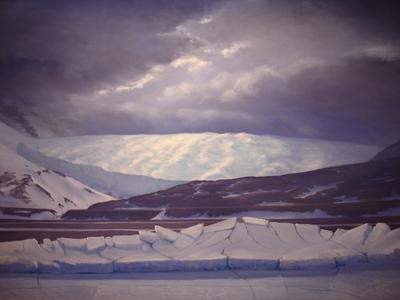
3. A painting in the galley by David Rosenthal. Kathy said that he used to teach painting classes and the class would do the painting together, using his sketch. He also memorized the colors. He never wanted to see a photo of the site before he had done the painting, because he said it would make him forget the colors he had seen.
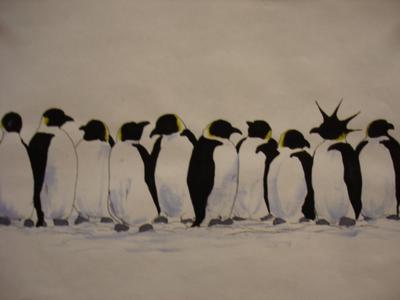
4. A penguin drawing on the bulletin board outside the station store.
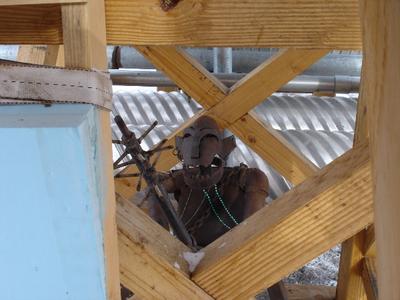
5. Troll art - we walk over this bridge several times a day.

6. Kathy takes a picture of the killer whale sculpture made of chains, reinforcing bar, and other assorted old bits of machines.
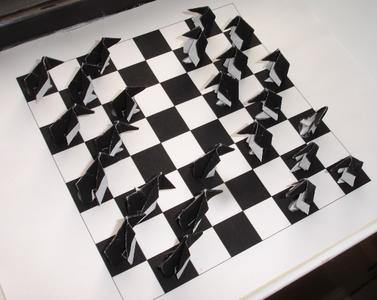
7. This origami penguin chess set lives on the windowsill in the stairwell of one of the dorms.

8. Kathy begins the job of picking out all the organisms in the samples, and identifying, sorting, and counting them.
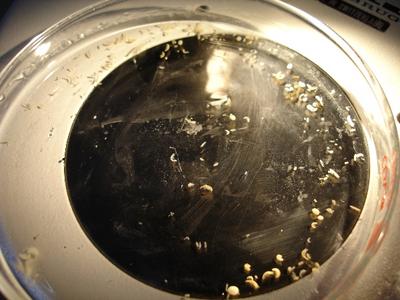
9. Work in progress - Kathy's petri dish with little organisms to identify.
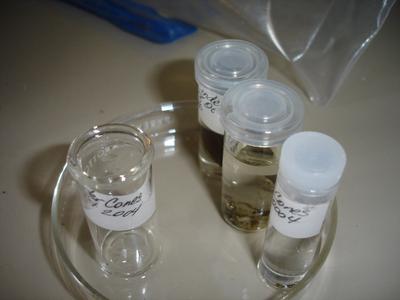
10. Organisms from the core samples separated into vials.
Contact the TEA in the field at
.
If you cannot connect through your browser, copy the
TEA's e-mail address in the "To:" line of
your favorite e-mail package.
|
